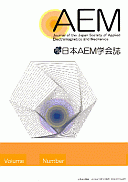Volume 25, Issue 3
Displaying 1-7 of 7 articles from this issue
- |<
- <
- 1
- >
- >|
Special Topic: The development of the assistive device and the medical device
-
2017Volume 25Issue 3 Pages 299-306
Published: 2017
Released on J-STAGE: October 23, 2017
Download PDF (3062K) -
2017Volume 25Issue 3 Pages 307-312
Published: 2017
Released on J-STAGE: October 23, 2017
Download PDF (1350K) -
2017Volume 25Issue 3 Pages 313-318
Published: 2017
Released on J-STAGE: October 23, 2017
Download PDF (1591K) -
2017Volume 25Issue 3 Pages 319-324
Published: 2017
Released on J-STAGE: October 23, 2017
Download PDF (5279K) -
2017Volume 25Issue 3 Pages 325-331
Published: 2017
Released on J-STAGE: October 23, 2017
Download PDF (1182K)
Regular Papers
-
2017Volume 25Issue 3 Pages 332-337
Published: 2017
Released on J-STAGE: October 23, 2017
Download PDF (1404K) -
2017Volume 25Issue 3 Pages 338-343
Published: 2017
Released on J-STAGE: October 23, 2017
Download PDF (1647K)
- |<
- <
- 1
- >
- >|
